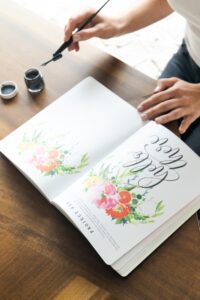Calligraphy is the art of beautiful handwriting, and it can be practiced using various tools and techniques. Nibs are one of the essential tools used in calligraphy. They are pointed metal tips that are attached to a pen or a holder and used for creating different lettering styles. Here’s a guide on calligraphy with nibs and other tools:
1. Nibs: Nibs come in different shapes and sizes, each producing a unique line variation and thickness. Some common nib types include:
– Pointed nibs: These nibs have a sharp point and are used for traditional calligraphy scripts like Copperplate, Spencerian, or modern script styles. They can create thin hairlines and thick downstrokes, offering great flexibility in line variation.
– Broad-edge nibs: These nibs have a flat or angled edge and are used for broad-edged calligraphy styles such as Italic, Gothic, or Uncial. They create thick lines on the downstrokes and thin lines on the upstrokes.
2. Pen Holders: Nibs are attached to pen holders or nib holders. Pen holders come in different materials like wood, plastic, or metal. Choose a holder that feels comfortable in your hand and allows for a firm grip.
3. Ink: High-quality calligraphy ink is essential for achieving good results. You can use bottled ink or ink cartridges specifically designed for calligraphy. Experiment with different ink colors and viscosities to achieve your desired effect.
4. Paper: Choose smooth, heavyweight paper that won’t bleed or feather when the ink is applied. Calligraphy practice pads or layout paper are popular
choices. Avoid rough or textured paper as it can snag the nib and disrupt the flow of ink.
5. Dip Pen Technique: When using a nib, dip the nib into the ink, making sure it covers the vent hole (if present) and the slit. Remove excess ink by gently touching the nib’s tip on the side of the ink container. Hold the pen at a 45-degree angle to the paper and apply consistent pressure while writing. Adjust the angle and pressure to achieve the desired line thickness and variation.

6. Practice: Regular practice is crucial for developing calligraphy skills. Start with basic exercises to familiarize yourself with the nib and ink flow. Practice individual letters, then move on to connecting letters and forming words. Study different calligraphy scripts and styles to expand your repertoire.
7. Maintenance: After each use, clean the nib with water or pen cleaner to prevent the ink from drying and clogging the nib. Dry the nib thoroughly before storing it to avoid rusting. Replace the nib when it becomes worn or damaged.
Remember, calligraphy is a skill that requires patience and practice. Enjoy the process and embrace the beauty of creating art through the written word.
Penkraft conducts classes, course, online courses, live courses, workshops, teachers’ training & online teachers’ training in Handwriting Improvement, Calligraphy, Abacus Maths, Vedic Maths, Phonics and various Craft & Artforms – Madhubani, Mandala, Warli, Gond, Lippan Art, Kalighat, Kalamkari, Pichwai, Cheriyal, Kerala Mural, Pattachitra, Tanjore Painting, One Stroke Painting, Decoupage, Image Transfer, Resin Art, Fluid Art, Alcohol Ink Art, Pop Art, Knife Painting, Scandinavian Art, Water Colors, Coffee Painting, Pencil Shading, Resin Art Advanced etc. at pan-India locations. With our mission to inspire, educate, empower & uplift people through our endeavours, we have trained & operationally supported (and continue to support) 1500+ home-makers to become Penkraft Certified Teachers? in various disciplines.

